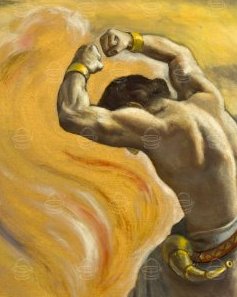
Biblical Cycle
In the 1960s, Kadish began a series of five paintings based on stories from the Hebrew Bible.
Biblical narrative paintings played a big role in the history of Western Art. Unlike Christian artists who usually drew inspiration from the Christian Bible (‘New Testament’), NMK drew exclusively on the Hebrew Bible for his subject matter - this reflected his Jewish background. This is especially obvious in Jacob and the Angel, where the angel is depicted as an incorporeal yellow mist, much more in keeping with the non-representational Jewish religious tradition than the winged humans of Renaissance Art.
Still, his Biblical pictures do not really fall into the category of religious art. The artist was attracted to the drama of the Biblical stories as a vehicle for painting people and creating the complex compositions at which he excelled. The canvases are modest in size, no more than 20 by 30 inches (51 by 76 cm), but he would no doubt have liked to have created grand murals if given the chance, in keeping with the epic subject matter that he chose.
The Biblical paintings were meticulously researched for appropriate costume and landscape. As with all of his big figure compositions, NMK made lots of preliminary studies, relying on photography when he could not find professional models. The striking similarity of some of the characters to Norman and Renée can be explained by the fact that they themselves posed, as sometimes did their daughters when they were teenagers.
The remaining four paintings were inspired by episodes described in the books of Joshua, Judges and Daniel. They are presented here according to the sequence of the episodes in the Bible, rather than in the strict chronological order of when they were executed.